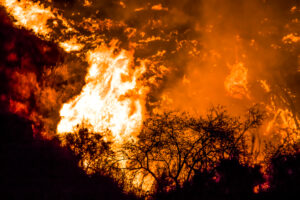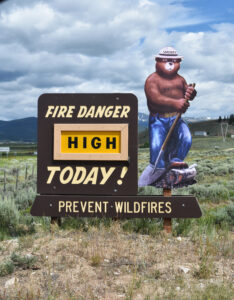Growing up in California, I remember summer as fire season. Every year the vegetation in the hills around us would dry out. Then it would take just one careless camper or smoker, or maybe a lightning strike, to set off a wildfire. Massive efforts went into fighting these blazes, but only the winter rains would truly put an end to them. Fire management meant fire suppression at all costs. But with wildfires growing increasingly severe, we need to rethink fire management.

We’ve discussed how both traditional architecture and biomimicry can inform sustainable design. Indigenous land management also has a lot to teach us about sustainability, including sustaining the commons. Historically, many western tribes deliberately set fires. In some cases this cultural burning was for fire management. But some tribes used cultural burning to foster the growth of food-bearing plants or improve the habitat of game animals.
Indigenous peoples comprise only 5% of the world’s population but protect approximately 85% of the world’s biodiversity… Much of this is attributed to long-term and widespread relationships with and dependence on fire, which has been applied as a tool for managing landscapes for millennia. Fortunately, the revitalization of Indigenous fire stewardship is demonstrating the value of routinely applying controlled fire to adapt to changing environments…—Hoffman et al., PNAS, Vol. 118, No. 32, 2021.
The westward expansion of European-American settlements resulted in suppression of Indigenous cultures, including land management practices. Modern researchers seeking to learn from these cultures employ a multidisciplinary approach, informing science with traditional Indigenous knowledge. For example, cores of the soil may provide a scientific record of plant growth and fires. But tribe members can inform researchers of specific practices—both the “what” and the “why”—in cultural burning. And because they’ve inhabited the same land for millennia, they know how it has changed.
Climate change and fire
Fire science has been reactive in that it responds to agency opportunities and conducts research in response to past fires. It is essential that we transition from this reactive stance to proactively thinking about tomorrow’s needs by…anticipating future fire activity.—Shuman et al., PNAS Nexus 4 August 2022.
There’s no doubt that climate change has brought longer, hotter, and drier summers in the western United States. The region is experiencing its longest, most severe drought in centuries. These factors have increased the number and severity of wildfires, but that’s not all that’s going on.
More and more people are building homes adjacent to fire-prone wilderness areas. In North America, the wildland-urban interface has expanded by more than 30% since 1970. That puts more people and property in harm’s way. Where it might once have made sense to let a fire burn itself out, now it’s much likelier to encroach on someone’s home.

Government and fire management
We’ve discussed previously how public policy can mitigate the effects of natural disasters. In the case of wildfires, a local government might decline building permits for certain areas. Local governments can maintain firebreaks or require homeowners to do so. And local governments are responsible for evacuation plans as well, including requirements for multiple egress routes. Both local and state governments may develop resiliency plans.
Building codes are normally the purview of state governments. They may mandate the use of fireproof or -resistant building materials or set minimum distances for offsets from property lines.
State governments also regulate utilities. California’s Pacific Gas & Electric agreed to pay $55 million for the 2021 Dixie fire and the 2019 Kincade fire. Fire officials blame PG&E’s transmission lines for igniting these fires. PG&E agreed to 5 years’ external monitoring as part of the settlement.
The federal government also plays a role because of its vast land holdings—640 million acres, most of which are in the western states. As the owner, it’s responsible for fire management and coordinates firefighting. Smokey the Bear’s slogan, “Only you can prevent forest fires,” was a federal advertising campaign when I was growing up. But after a century and a half of fire suppression, it’s past time to reconsider that mindset.
Fire management in the ancient Southwest
The wildland-urban interface in a fire-prone landscape is nothing new in the Southwest of the United States. Ancient settlements in northern New Mexico dating from the 1100s began with burning to clear land for agriculture. After that, they deliberately set fires to facilitate the growth of food plants, process wild resources, prepare trees for use in building, and improve habitat for large herbivores. These practices, along with the gathering of wood for cooking, heating, and building, kept the fuel load of the surrounding wildlands in check. Such conditions favored small, frequent fires over infrequent conflagrations. The gathering of wood for domestic uses naturally concentrated in the areas near villages, creating a firebreak between them and the wildlands.
[H]uman communities have lived in [wildland-urban interface]-like conditions for millennia. In the fire-prone, dry conifer forests of western North American, Native American settlements apparently existed in [wildland-urban interface]-like conditions since the adoption of agriculture and the emergence of village life. In the Jemez Mountains of northern New Mexico…large communities of Ancestral Pueblo farmers…lived for more than 500 y in ponderosa pine forest, which are adapted to frequent..low-severity fires.—Roos et al., PNAS, Vol. 118, No. 4, 2021.
Climate change and drought have affected this region before. Between 1100 and 1650 the Ancestral Pueblo people coped with severe droughts in the 1200s, 1400s, and 1500s. Yet widespread fires did not occur until after a population collapse in 1650. Even so, it was only in the latter part of the 20th century that fire intensity and severity dramatically increased. That is, modern fire suppression has produced worse outcomes than either Indigenous land management or no management at all.
Indigenous land management in the Klamath Mountains
Fire is crucial to who people are, and what they do. It enables them to live. It is a central component of that duty of care for the whole world, which is inherited from their common ancestry as Spirit People.—Charlie Thom, Member of the Karuk tribe, 1996
The Karuk and Yurok tribes have traditionally gathered food from their lands in northern California. They deliberately ignited fires to facilitate growth of food and fiber, clear travel routes, promote hunting, and reduce pest populations. They practiced patch burning to maintain trails, reduce pests, and promote the growth of roots and berries. Broadcast burning, on the other hand, promoted habitat conversion, nut- and acorn harvesting, and hunting. Acorns, nuts, berries, mushrooms, and weaving materials thrive in open forest. But fire suppression following Euro-American colonization has left the forest with too many trees and too much woody debris. Land that supported a population of 2700 in the mid-19th century isn’t nearly so productive now.
Indigenous depopulation after AD 1800, coupled with 20th-century fire suppression, likely allowed biomass to increase, culminating in the current landscape: a closed Douglas fir-dominant forest unlike any seen in the preceding 3,000 y. These findings are consistent with precontact forest conditions being influenced by Indigenous land management and suggest large-scale interventions could be needed to return to historic forest biomass levels.—Knight et al., PNAS, Vol. 119, No. 12, 2022.
